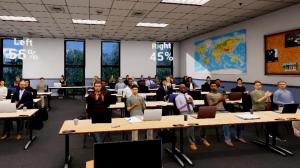VNR: Interactive VR lab at UH Mānoa helps sharpen public speaking skills
University of Hawaiʻi at MānoaLink to video and sound (details below): https://go.hawaii.edu/tfX
WHAT: The University of Hawaiʻi at Mānoa has a new interactive, state-of-the-art virtual reality (VR) lab to help students, faculty and staff sharpen their public speaking skills. Managed by the Center for Communicating Scientific Information in the Communicology Program, the lab features a VR headset and innovative software that delivers immediate feedback (a variety of criteria from eye contact to hand gestures) after users practice their speeches.
Funding for the VR lab was provided through extramural funding from the National Science Foundation (NSF). Extramural funding is external investments from the federal government, industry and non-profit organizations that support research and academic activities conducted by university faculty and staff.
WHY: Public speaking is a key skill in a variety of disciplines. The goals of the VR lab are to help users develop their public speaking skills, and for researchers to better communicate their research—that can be technical—in ways that people can understand and use in the future.
WHO: UH Mānoa students, faculty and staff
WHERE: UH Mānoa Center for Communicating Scientific Information in the Communicology Program, George Hall
ADDITIONAL DETAILS:
- How it works: when someone arrives for their appointment, they go through a quick training session by the student research assistant. After putting on the VR headset, they will select a setting, consisting of either an open prompt or a guided prompt with a specific question to address. They will also choose the type of audience environment, which ranges from polite to “hostile.” While giving the speech, the user will see the setting as if they are speaking in front of a real audience. Afterwards, the program immediately delivers feedback.
- According to project leaders, the feedback from users has been overwhelmingly positive.
- The NSF grant was part of UH’s record extramural funding of $505 million in fiscal year 2022.
- The lab is currently only open to the UH community, with priority given to researchers on the National Science Foundation grant. Eventually, project leaders would like to open the lab up to the public, including K-12 students, as a resource for public speaking activities, such as testifying at the state legislature or commemorating a loved one.
- In the future, they hope to see the lab expand into several rooms full of VR headsets and separate consulting rooms where people can receive communication skills and public speaking coaching.
- Visit the VR lab website for more information.
Link to video and sound (details below): https://go.hawaii.edu/tfX
VIDEO:
BROLL (1:05):
0:00 - 0:27: Lauren Masquida, undergraduate research assistant, performing a practice speech on studying foreign languages. Video contains multiple views, including the speaker’s point of view.
0:28 - 0:35: Exterior of George Hall
0:36 - 1:05: Additional video of the VR lab and the speech, which ends with applause from the audience
SOUNDBITES:
Amy Ebesu Hubbard, UH Mānoa communicology professor and project leader
(:17)
“A virtual reality setup gives you a kind of blend of both worlds—gets you an opportunity to practice but also gives you a way of playing it like a game to improve your score so that’s why it’s a really cool tool to be able to bring to the university and have people experience it.”
Paige Barnett, UH Mānoa communicology student and undergraduate research assistant
(:12)
“In a lot of my classes, I have group projects that I present and presentations I do myself so it’s really cool being able to just go in there, and practice, and see my analytics and improve in any way that I can.”
Jay Stout, UH Mānoa communicology lecturer teaching public speaking courses
(:14)
“It’s very valuable. Often what we see in public speaking is that a lot of students suffer from anxiety so having an opportunity for them to practice and to go through the motions of a speech without a live audience just yet, is really beneficial for them.”


